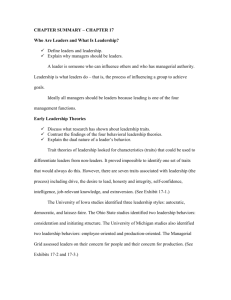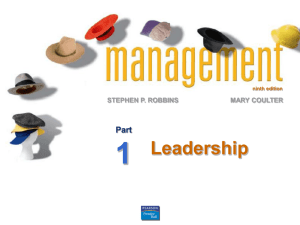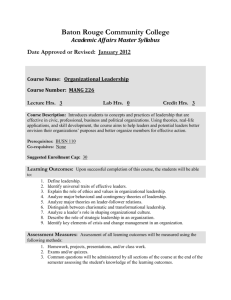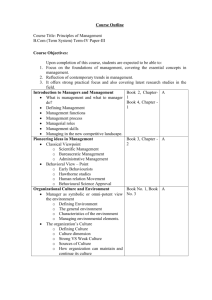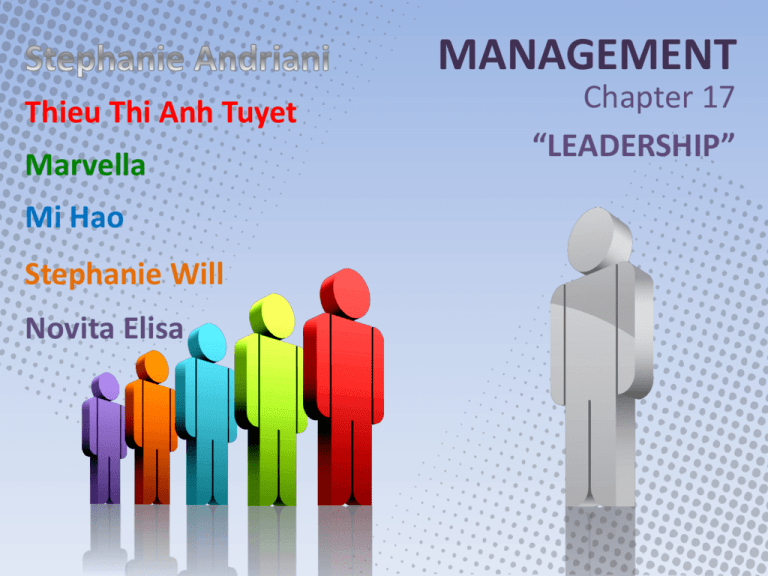
MANAGEMENT
Thieu Thi Anh Tuyet
Marvella
Mi Hao
Stephanie Will
Novita Elisa
Chapter 17
“LEADERSHIP”
LEARNING OUTLINE
Follow this Learning Outline as you read and study this chapter.
Who are Leaders and What is Leadership?
• Define leaders and leadership
• Explain why managers should be leader
Early Leadership Theories
• Discuss what research has shown about leadership traits.
• Contrast the findings of the four behavioral leadership theories.
• Explain the dual nature of a leader’s behavior.
Contingency Theories of Leadership
• Explain how Fiedler’s theory of leadership is a contingency model.
• Contrast situational leadership and the leader participation model.
• Discuss how path-goal theory explains leadership.
L E A R N I N G O U T L I N E (Cont’d)
Follow this Learning Outline as you read and study this chapter.
Cutting Edge Approaches to Leadership
• Differentiate between transactional and transformational leaders.
• Describe charismatic and visionary leadership.
Leadership Issues in the Twenty-First Century
• Tell the five sources of leader’s power.
• Discuss the issues today’s leaders face.
• Explain why leadership is sometimes irrelevant.
Who are Leaders and What is
Leadership?
Leaders: Someone who can
influence others and who has
managerial authority.
Leadership: the process of
influencing a group to achieve
goals.
EARLY
THEORY
Early Leadership Theories
Trait Theories (1920s–1930s)
Research in the 1920s and 1930s, focused on leader
traits with the intent to isolate one or more traits that
leaders possessed, but that nonleaders did not.
Seven traits associated with effective leadership:
Drive, the desire to lead, honesty and integrity, selfconfidence, intelligence, job-relevant knowledge, and
extraversion.
Management
6
Exhibit 17-1
Seven Traits Associated with Leadership
• Drive:leader exhibit a high effort level.
• Desire to lead: Leaders have a strong desire to influence and
lead others.
• Honesty and integrity
• Self-confidence: Followers look to leaders for an absence of
self doubt.
• Intelligence: Large information, to create visions, solve
problems.
• Job-relevant knowledge
• Extraversion: Leaders are energetic, lively people.
Management
7
Early Leadership Theories (Cont’d)
Behavioral Theory
University of Iowa Studies (Kurt
Lewin)
– Identified three leadership styles:
• Autocratic style: centralized authority, low
participation
• Democratic style: involvement, high
participation, feedback
• Laissez-faire style: hands-off management
– Research findings: mixed results
• No specific style was consistently better
for producing better performance
• Employees were more satisfied under a
democratic leader than an autocratic
leader
Thieu thi anh tuyet
8
Early Leadership Theories (Cont’d)
Behavioral Theory (Cont’d)
Ohio State Studies
– Identified two dimensions of leader behaviour
• Initiating structure: the role of the leader in defining his or her
role and the roles of group members
• Consideration: the leader’s mutual trust and respect for group
members’ ideas and feelings
– Research findings: mixed results
• High-high leaders generally, but not always, achieved high
group task performance and satisfaction
• Evidence indicated that situational factors appeared to
strongly influence leadership effectiveness
Management
9
Early Leadership Theories (Cont’d)
Behavioral Theory (Cont’d)
University of Michigan Studies
– Identified two dimensions of leader
behaviour
• Employee oriented: emphasizing
personal relationships
• Production oriented: emphasizing task
accomplishment
– Research findings:
• Leaders who are employee oriented
are strongly associated with high group
productivity and high job satisfaction
Management
10
Early Leadership Theories (Cont’d)
Behavioral Theory (Cont’d)
Managerial Grid
– Appraises leadership styles using two dimensions:
• Concern for people
• Concern for production
Management
11
Exhibit 17.2
The
Managerial
Grid
Source: Reprinted by
permission of Harvard Business
Review. An exhibit from
“Breakthrough in Organization
Development” by Robert R.
Blake, Jane S. Mouton, Louis B.
Barnes, and Larry E. Greiner,
November–December 1964, p.
136. Copyright © 1964 by the
President and Fellows of
Harvard College. All rights
reserved.
Management
12
Contingency Theories of
Leadership
Contingency Theories
The Fiedler Model
Hersey and Blanchard’s Situational Leadership
Theory (SLT)
Leader Participation Model
Path-Goal Model
Contingency Theories (Cont’d)
The Fiedler Model
The effective group performance depends upon
the proper match between the leader’s style
interacting with the followers.
To define leadership styles and different types of
situations and then to identify the appropriate
combinations of style and situation.
Use The Least-Preferred Co-worker (LPC)
Questionnaire
A questionnaire that measured whether a
leader as task-oriented or relationship-oriented.
Contingency Theories (Cont’d)
The Fiedler Model (Cont’d)
Three Contigency Dimensions
– Leader-member relations
• rated as either good or poor.
– Task structure
• rated as either high or low.
– Position power
• rated as either strong or weak.
Exhibit 17.3 - Fiedler Model
Contingency Theories (Cont’d)
Hersey and Blanchard’s SLT
A leadership contingency theory that focuses
on the follower’s readiness.
Four Leadership Styles
– Telling (high task-low relationship)
– Selling (high task-high relationship)
– Participating (low task-high relationship)
– Delegating (low task-low relationship)
Contingency Theories (Cont’d)
Hersey and Blanchard’s SLT (Cont’d)
Four Stages of Follower Readiness
– R1: unable and unwilling.
– R2: unable but willing.
– R3: able but unwilling.
– R4: able and willing.
Exhibit 17.4 - Hersey and Blanchard’s SLT Model
Contingency Theories (Cont’d)
Leader Participant Model
A leadership contingency model that related leadership
behavior and participation in decision making.
Developed by Victor Vroom and Phillip Yetton
Leadership Style in Vroom Leader Participant Model
– Decide: decision maker.
– Consult individually: ask suggestions from group members
individually.
– Consult group: ask suggestions from group members in a
meeting.
– Facilitate: Facilitator, defines problems and boundaries.
– Delegate: Group makes the decision within prescribed limits.
Contingency Theories (Cont’d)
Path Goal Model
Leader must assist the followers in attaining their
goals and to provide the direction needed to ensure
that their goals are compatible with the objectives.
House’s Leadership Behaviors:
– Directives Leader
– Supportive Leader
– Participated Leader
– Achievement-oriented Leader
Exhibit 17.5 – Path Goal Model
Contemporary Views on
Leadership
Transformational-Transactional Leadership
What are transactional leaders?
• Leader who guide and motivate their
followers in the direction of set goals
by clarifying role and task requirement.
What is a transformational leader?
Leaders who inspires followers to
transcend their own self-interests for
the good of the organization, and who
is capable of having an important effect
on his followers.
Distinguish transactional and
transformational leadership.
Transformational leadership is built on
top of transactional leadership.
Charismatic-Visionary Leadership
• What is charismatic-leadership?
• The skills do charismatic leader’s exhibit?
– Enthusiastic
– Self Confidence
– Action influence people to behave in certain ways
• What is visionary leadership?
• What skills do visionary leader’s exhibit?
–
–
–
Ability to explain the vision to others.
Ability to express the vision not just verbally but
through behavior.
Ability to extend to apply the vision to different
leadership contexts.
Team Leadership
What is team leadership?
How to become an effective team leader?
Have the patience to share information
Being able to trust other to give up authority
Understanding when to intervene
Have mastered the difficulties balancing act of knowing
when to leave and involve their team
Some priorities entail four specific leadership roles
Liaisons with external constituencies
Troubleshooters
Conflict managers
Coaches
LEADERSHIP IN
CENTURY
ST
21
LEADERSHIP ISSUE IN 21ST CENTURY
Managing Power
– Legitimate power
• The power a leader has as a result of his or
her position.
– Coercive power
• The power a leader has to punish or
control.
– Reward power
• The power to give positive benefits or
rewards.
– Expert power
• The influence a leader can exert as a result
of his or her expertise, skills, or knowledge.
– Referent power
• The power of a leader that arise because of
a person’s desirable resources or admired
personal traits.
LEADERSHIP ISSUE IN 21ST CENTURY
(Cont’d)
Developing Credibility and Trust
– Credibility
• The assessment of a leader’s honesty,
competence, and ability to inspire by
his or her followers
– Trust
• The belief of followers and others in
the integrity, character, and ability of a
leader.
• Dimensions of trust: integrity,
competence, consistency, loyalty, and
openness.
• Trust is related to increases in job
performance, organizational
citizenship behaviors, job satisfaction,
and organization commitment.
Exhibit 17-6 Suggestion for Building Trust
Practice openness.
Be fair.
Speak your feelings.
Tell the truth.
Show consistency.
Fulfill your promises.
Maintain confidences.
Demonstrate competence.
LEADERSHIP ISSUE IN 21ST CENTURY
(Cont’d)
Providing Ethical Leadership
– Ethics are part of leadership when
leaders attempt to:
• Foster moral virtue through changes
in attitudes and behaviors.
• Use their charisma in socially
constructive ways.
• Promote ethical behavior by
exhibiting their personal traits of
honesty and integrity.
– Moral leadership:
• Involves addressing the means that a
leader uses to achieve goals as well
as the moral content of those goals.
LEADERSHIP ISSUE IN 21ST CENTURY
(Cont’d)
Providing Online Leadership
• Focusing on managing virtual teams
using the development of
technology.
• There are also challenges in providing
online leadership : communication,
performance management and trust.
–Challenges in Providing Online Leadership
• Communication
– leader may need to learn new communication skills
because the communication by using technology is
different from using face to face communication
• Managing Performance
– It can be done by defining, facilitating and encouraging it.
– Define : direct the employees
– Facilitate : reducing or eliminating obstacles to successful
performance and providing adequate resources
to get the job done
– Encouraging : providing sufficient rewards that virtual
employees really value
–Challenges in Providing Online Leadership
• Trust issue
– Whether the system is being used to monitor and evaluate
employees
– It is more important to create a culture where trust
among all participants is expected and required
– The five dimensions of trust is integrity, competence,
consistency, loyalty and openness
LEADERSHIP ISSUE IN 21ST CENTURY
(Cont’d)
Empowerment
– Involves increasing the decisionmaking discretion of workers
such that teams can make key
operating decisions in develop
budgets, scheduling workloads,
controlling inventories, and
solving quality problems.
– Why empower employees?
• Quicker responses problems and
faster decisions.
• Address the problem of increased
spans of control in relieving
managers to work on other
problems.
Stephen R. Covey, Principle-centered Leadership
LEADERSHIP ISSUES IN 21st CENTURY
(con’t)
Cross-Cultural Leadership
• Leadership style based on national culture
• The universal appeal of these transformational
leader characteristics is due to pressure toward
common technologies and management practices
as a result of global competitiveness and
multinational influences
LEADERSHIP ISSUES IN 21st CENTURY
(con’t)
• Gender Differences and Leadership
“Do males and females lead differently? ” accurately
characterized as a purely academic issue interesting but
not relevant.
A number of studies focusing on gender and leadership
style have been conducted in recent years.
LEADERSHIP ISSUES IN 21st CENTURY
(con’t)
• Gender Differences in Leadership Styles
– Women tend to adopt a more democratic or
participative style and a less autocratic or directive
style than men do
– Women are more like encourage participation, share
power ad information and attempt to enhance
followers self worth
– Men are more likely to use a directive command and
control styles
– Men rely on the formal authority of their position for
their influence base
– Men use transactional leadership, handing
out rewards for good work and punishment
for bad
Exhibit 17-11 Where Female Managers Do Better: A
Scorecard
None of the five studies set out to find gender differences. They stumbled on them while
compiling and analyzing performance evaluations.
Skill (Each check mark denotes which group
scored higher on the respective studies)
MEN
WOMEN
Motivating Others
Fostering Communication
*
Producing High-Quality Work
Strategic Planning
*
Listening to Others
Analyzing Issues
* In one study, women’s and men’s scores in these categories were statistically even.
Data: Hagberg Consulting Group, Management Research Group, Lawrence A. Pfaff, Personnel
Decisions International Inc., Advanced Teamware Inc.
Source: R. Sharpe, “As Leaders, Women Rule,” BusinessWeek, November 20. 2000, p. 75.
*
LEADERSHIP ISSUES IN 21st CENTURY
(con’t)
• The Demise of Celebrity Leadership
Business leader seem to be losing their luster.
Demise have two factors :
• That obviously has contributed to this shift of opinion
is the publicity from ongoing ethical ad financial
scandals at both for profit and nonprofit organizations
around the world.
• The controversy surrounding executive pay.
Example of a CEO
Mr. Sudhamek
Agoeng
Wospodo
Soejoto,
CEO of Garuda
Food Company
Some suggestions CEO need to back to the
basics of what it means to be a Leader
• Give people a reason to come to work.
• Be loyal to the organization’s people
• Spend time with people who do the real
work for the organization.
• Be more open and more candid about
what business practices are acceptable
and proper and how the unacceptable
ones should be fixed.
LEADERSHIP ISSUES IN 21st CENTURY
(con’t)
• Substitutes for Leadership
Some situations, any behaviors a leader exhibits are
irrelevant.
Becoming a Manager
As you interact with various organizations, note the
different styles used by the leaders in those
organizations.
Thinks of people that you would consider effective
leaders and try to determine why they’re effective.
If you have the opportunity, take the leadership
development course.
Practice building trust in relationship that you have with
others.
Read the books on great leaders (not just business
leaders) and on leadership development topics
Terms to Know
•
•
•
•
•
•
•
•
•
Leader
Leadership
Traits Theory
Behavioral Theory
Managerial Grid
Fiedler Model
LPC Questionnaire
SLT
Leader Participant
Model
• Path-Goal Model
• Transformational
leadership
• Transactional
leadership
•
•
•
•
•
•
•
•
•
•
•
•
•
•
•
Visionary leader
•
Charismatic leadership •
Team leadership
•
Legitimate Power
Coercive Power
•
Reward Power
Expert Power
Referent Power
Credibility
Trust
Ethical leadership
Moral leadership
Online Leadership
Abbreviation
Emoticons
Jargon
Gender Differences
and Leadership
The Demise of
Celebrity Leadership
Substitutes for a
Leadership
Starring
Teacher T. Manivasugen
Class Captain Hafid Pradipta
Speakers Thieu Thi Anh Tuyet
Marvella
Mi Hao
Stephanie Andriani
Stephanie Will
Novita Elisa
Class Management Class 1

